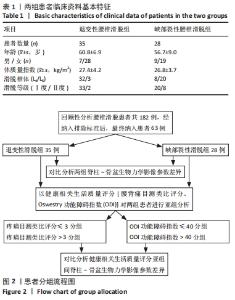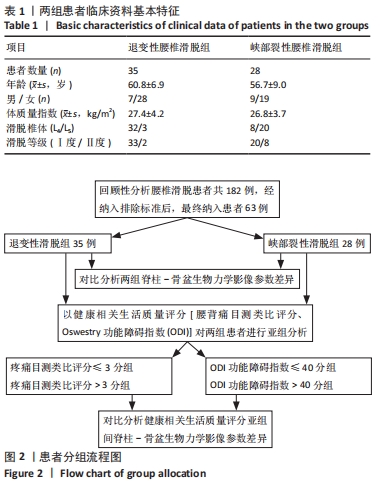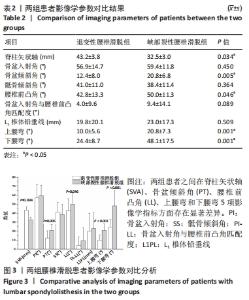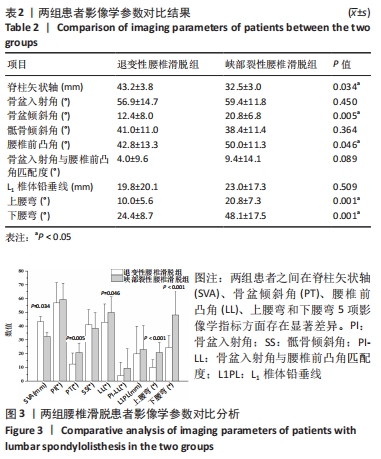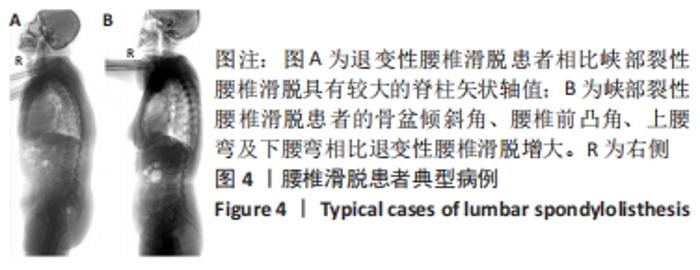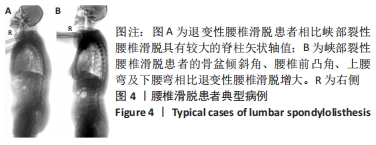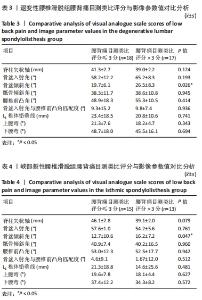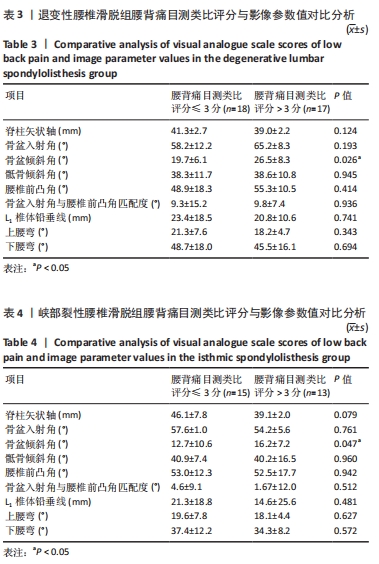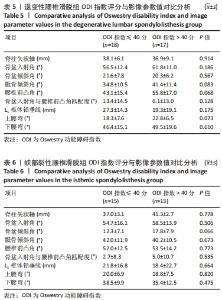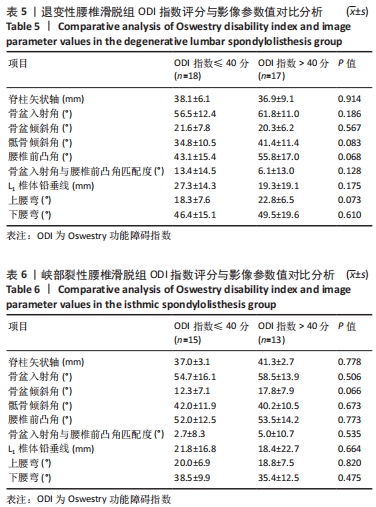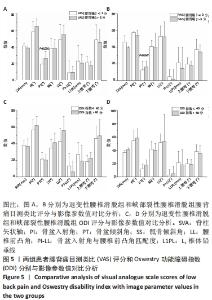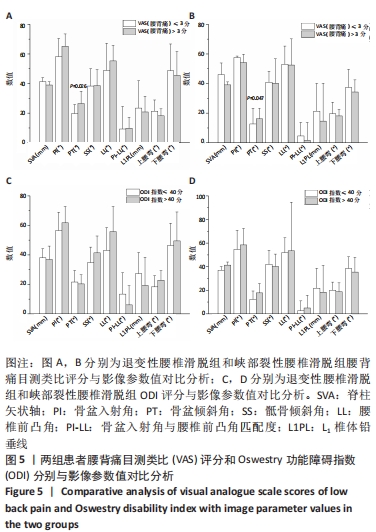[1] AIHARA T, TAKAHASHI K, YAMAGATA M, et al. Does the iliolumbar ligament prevent anterior displacement of the fifth lumbar vertebra with defects of the pars? J Bone Joint Surg Br. 2000;82(6):846-850.
[2] MEYERDING HW. Spondylolisthesis. Surg Gynecol Obstet. 1932;54:371-377.
[3] LIM JK, KIM SM. Difference of Sagittal Spinopelvic Alignments between Degenerative Spondylolisthesis and Isthmic Spondylolisthesis. J Korean Neurosurg Soc. 2013;53(2):96-101.
[4] 陈涛,贾世青,陈武,等.椎体间融合内固定治疗腰椎滑脱症:脊柱-骨盆参数的变化[J].中国组织工程研究,2013,17(4):576-581.
[5] ZHANG GZ, DENG YJ, HE XG, et al. Different Types of Double-Level Degenerative Lumber Spondylolisthesis: What Is Different in the Sagittal Plane? World Neurosurg. 2021:S1878-8750(21)00318-1.
[6] HORTON WC, BROWN CW, BRIDWELL KH, et al. Is there an optimal patient stance for obtaining a lateral 36” radiograph? A critical comparison of three techniques. Spine (Phila Pa 1976). 2005;30(4):427-433.
[7] FAIRBANK JC, COUPER J, DAVIES JB, et al. The Oswestry low back pain disability questionnaire. Physiotherapy. 1980;66(8):271-273.
[8] MCCORMACK HM, HORNE DJ, SHEATHER S.Clinical applications of visual analogue scales: a critical review. Psychol Med. 1988;18(4):1007-1019.
[9] SMITH JS, SHAFFREY CI, BESS S, et al. Recent and Emerging Advances in Spinal Deformity. Neurosurgery. 2017;80(3S):S70-S85.
[10] HASEGAWA K, OKAMOTO M, HATSUSHIKANO S, et al. Normative values of spino-pelvic sagittal alignment, balance, age, and health-related quality of life in a cohort of healthy adult subjects. Eur Spine J. 2016;25(11):3675-3686.
[11] ROUSSOULY P, PINHEIRO-FRANCO JL. Sagittal parameters of the spine: biomechanical approach. Eur Spine J. 2011;20 Suppl 5(Suppl 5):578-585.
[12] DUVAL-BEAUPÈRE G, SCHMIDT C, COSSON P. A Barycentremetric study of the sagittal shape of spine and pelvis: the conditions required for an economic standing position. Ann Biomed Eng. 1992;20(4):451-462.
[13] LEGAYE J, DUVAL-BEAUPÈRE G, HECQUET J, et al. Pelvic incidence: a fundamental pelvic parameter for three-dimensional regulation of spinal sagittal curves. Eur Spine J. 1998;7(2):99-103.
[14] 周永富,常晓涛,武凯,等.腰骶角和腰椎曲度的相关性研究[J].中国实用医药,2019,14(36):14-16.
[15] ROUSSOULY P, GOLLOGLY S, BERTHONNAUD E, et al. Classification of the normal variation in the sagittal alignment of the human lumbar spine and pelvis in the standing position. Spine (Phila Pa 1976). 2005;30(3):346-353.
[16] VAZIFEHDAN F, KARANTZOULIS VG, IGOUMENOU VG, et al. Sagittal alignment assessment after short-segment lumbar fusion for degenerative disc disease. Int Orthop. 2019;43(4):891-898.
[17] 周思宇,孙卓然,李危石.矢状位平衡影像学评价之争议与现状[J].中国修复重建外科杂志,2018,32(11):1365-1370.
[18] RADOVANOVIC I, URQUHART JC, GANAPATHY V, et al. Influence of postoperative sagittal balance and spinopelvic parameters on the outcome of patients surgically treated for degenerative lumbar spondylolisthesis. J Neurosurg Spine. 2017; 26(4):448-453.
[19] RAJNICS P, TEMPLIER A, SKALLI W, et al. The association of sagittal spinal and pelvic parameters in asymptomatic persons and patients with isthmic spondylolisthesis. J Spinal Disord Tech. 2002;15(1):24-30.
[20] HANSON DS, BRIDWELL KH, RHEE JM, et al. Correlation of pelvic incidence with low- and high-grade isthmic spondylolisthesis. Spine (Phila Pa 1976). 2002; 27(18):2026-2029.
[21] GELB DE, LENKE LG, BRIDWELL KH,et al. An analysis of sagittal spinal alignment in 100 asymptomatic middle and older aged volunteers. Spine (Phila Pa 1976). 1995;20(12):1351-1318.
[22] BEEN E, GÓMEZ-OLIVENCIA A, SHEFI S, et al. Evolution of Spinopelvic Alignment in Hominins. Anat Rec (Hoboken). 2017;300(5):900-911.
[23] RAJNICS P, TEMPLIER A, SKALLI W, et al. The importance of spinopelvic parameters in patients with lumbar disc lesions. Int Orthop. 2002;26(2):104-108.
[24] JACKSON RP, KANEMURA T, KAWAKAMI N, et al. Lumbopelvic lordosis and pelvic balance on repeated standing lateral radiographs of adult volunteers and untreated patients with constant low back pain. Spine (Phila Pa 1976). 2000; 25(5):575-586.
[25] KOROVESSIS P, DIMAS A, ILIOPOULOS P, et al. Correlative analysis of lateral vertebral radiographic variables and medical outcomes study short-form health survey: a comparative study in asymptomatic volunteers versus patients with low back pain. J Spinal Disord Tech. 2002;15(5):384-390.
[26] SCHWAB FJ, BLONDEL B, BESS S, et al. International Spine Study Group (ISSG). Radiographical spinopelvic parameters and disability in the setting of adult spinal deformity: a prospective multicenter analysis. Spine (Phila Pa 1976). 2013; 38(13):E803-812.
[27] STAGNARA P, DE MAUROY JC, DRAN G, et al. Reciprocal angulation of vertebral bodies in a sagittal plane: approach to references for the evaluation of kyphosis and lordosis. Spine (Phila Pa 1976). 1982;7(4):335-342.
[28] 赵耀,李淳德,孙浩林.脊柱矢状位平衡的影像学参数及分型的研究进展[J].中国脊柱脊髓杂志,2012,22(7):651-655.
|
